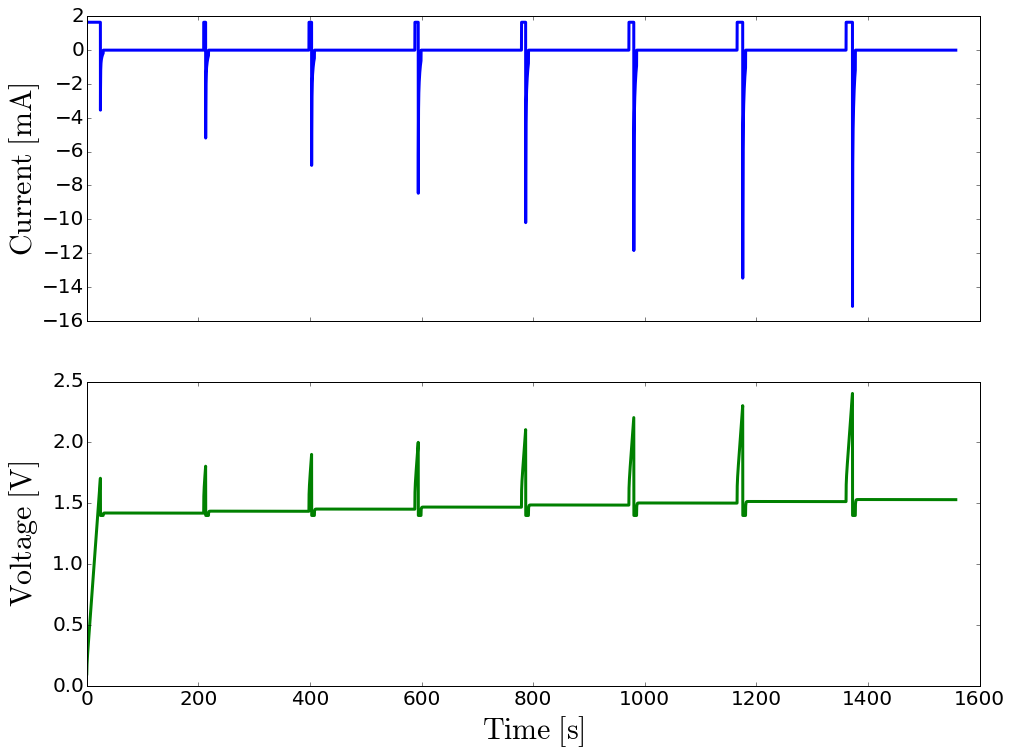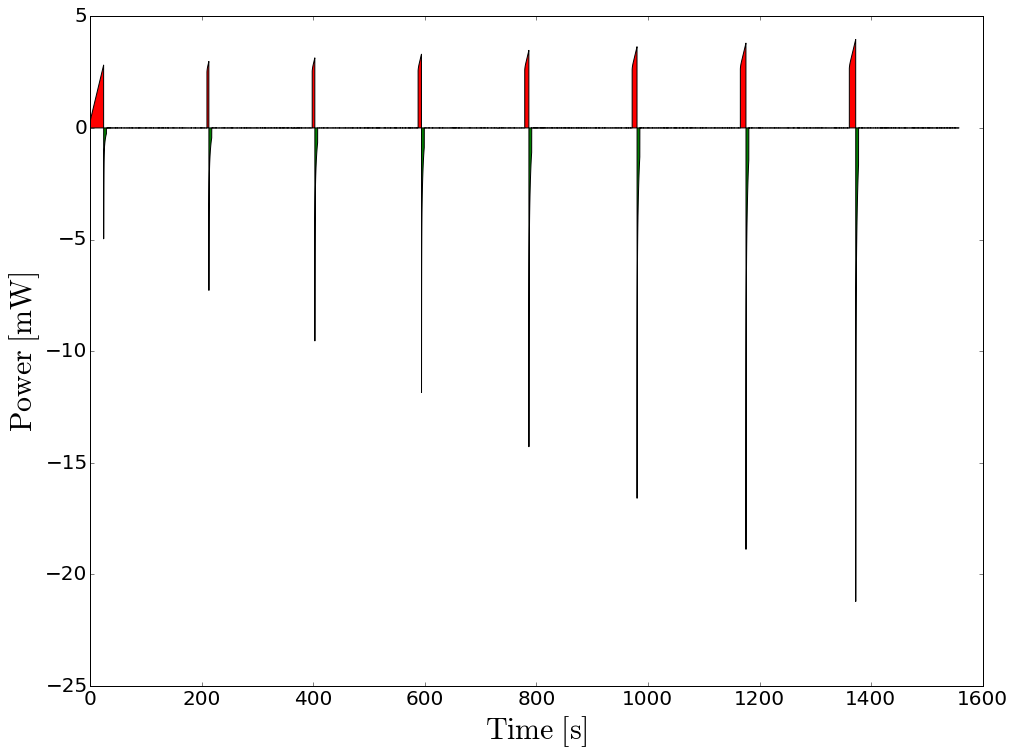Examples¶
Constant current charge constant voltage discharge¶
This is based on [Journal of The Electrochemical Society, 152 (5)
D79-D87 (2005)] by M. Verbrugge and P. Liu. It illustrates how easy it
is to specify complex operating conditions for energy storage devices in
pycap.
from pycap import EnergyStorageDevice,PropertyTree
from pycap import initialize_data,report_data,plot_data
from matplotlib import pyplot
%matplotlib inline
The supercapacitor is initially fully discharged. It is charged to
 at a constant current of
at a constant current of
 . Subsequently, a constant
. Subsequently, a constant
 is applied for
is applied for  and the
supercapacitor is allowed to rest at open circuit potential for
and the
supercapacitor is allowed to rest at open circuit potential for
 . This sequence is repeated for a series of
charge potentials at
. This sequence is repeated for a series of
charge potentials at  increments from
increments from  to
to  . The routine defined below,
. The routine defined below,
run_verbrugge_experiment, implements that experiment and records
measurements for the time, current and voltage.
def run_verbrugge_experiment(device):
charge_current=1.65e-3 # ampere
discharge_voltage=1.4 # volt
discharge_time=5.0 # second
rest_time=180.0 # second
time_step=0.1 # second
time=0.0
data=initialize_data()
for charge_voltage in [1.7,1.8,1.9,2.0,2.1,2.2,2.3,2.4]:
# constant current charge
while device.get_voltage()<charge_voltage:
time+=time_step
device.evolve_one_time_step_constant_current(time_step,charge_current)
report_data(data,time,device)
# constant voltage discharge
tick=time
while time-tick<discharge_time:
time+=time_step
device.evolve_one_time_step_constant_voltage(time_step,discharge_voltage)
report_data(data,time,device)
# rest at open circuit
tick=time
while time-tick<rest_time:
time+=time_step
device.evolve_one_time_step_constant_current(time_step,0.0)
report_data(data,time,device)
return data
Make an energy storage device (here a supercapacitor) and run the experiment.
input_database=PropertyTree()
input_database.parse_xml('super_capacitor.xml')
# no faradaic processes
input_database.put_double('device.material_properties.electrode_material.exchange_current_density',0.0)
device=EnergyStorageDevice(input_database.get_child('device'))
# run experiment
data=run_verbrugge_experiment(device)
Postprocess the results.
time=data['time']
current=data['current']
voltage=data['voltage']
label_fontsize=30
tick_fontsize=20
labelx=-0.05
labely=0.5
plot_linewidth=3
f,axarr=pyplot.subplots(2,sharex=True,figsize=(16,12))
axarr[0].plot(time,1e+3*current,'b-',lw=plot_linewidth)
axarr[0].set_ylabel(r'$\mathrm{Current\ [mA]}$',fontsize=label_fontsize)
axarr[0].get_yaxis().set_tick_params(labelsize=tick_fontsize)
axarr[0].yaxis.set_label_coords(labelx,labely)
axarr[1].plot(time,voltage,'g-',lw=plot_linewidth)
axarr[1].set_ylabel(r'$\mathrm{Voltage\ [V]}$',fontsize=label_fontsize)
axarr[1].set_xlabel(r'$\mathrm{Time\ [s]}$',fontsize=label_fontsize)
axarr[1].get_yaxis().set_tick_params(labelsize=tick_fontsize)
axarr[1].get_xaxis().set_tick_params(labelsize=tick_fontsize)
axarr[1].yaxis.set_label_coords(labelx,labely)
pyplot.show()

Plot the power versus time. The red surface area represents the energy used to charge the supercapacitor and the green on the power pulses is the energy recovered.
power=current*voltage
pyplot.figure(figsize=(16,12))
pyplot.fill_between(time,1e+3*power,0,where=power>0,facecolor='r')
pyplot.fill_between(time,1e+3*power,0,where=power<0,facecolor='g')
pyplot.xlabel(r'$\mathrm{Time\ [s]}$',fontsize=label_fontsize)
pyplot.ylabel(r'$\mathrm{Power\ [mW]}$',fontsize=label_fontsize)
pyplot.gca().get_xaxis().set_tick_params(labelsize=tick_fontsize)
pyplot.gca().get_yaxis().set_tick_params(labelsize=tick_fontsize)
pyplot.show()
